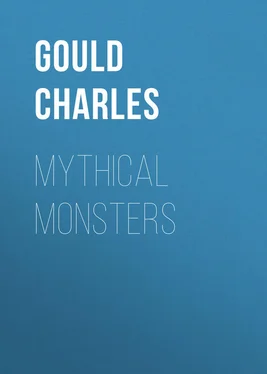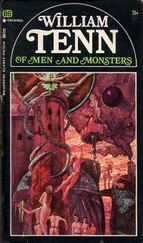Charles Gould - Mythical Monsters
Здесь есть возможность читать онлайн «Charles Gould - Mythical Monsters» — ознакомительный отрывок электронной книги совершенно бесплатно, а после прочтения отрывка купить полную версию. В некоторых случаях можно слушать аудио, скачать через торрент в формате fb2 и присутствует краткое содержание. Жанр: Мифы. Легенды. Эпос, Природа и животные, foreign_antique, foreign_prose, на английском языке. Описание произведения, (предисловие) а так же отзывы посетителей доступны на портале библиотеки ЛибКат.
- Название:Mythical Monsters
- Автор:
- Жанр:
- Год:неизвестен
- ISBN:нет данных
- Рейтинг книги:5 / 5. Голосов: 1
-
Избранное:Добавить в избранное
- Отзывы:
-
Ваша оценка:
- 100
- 1
- 2
- 3
- 4
- 5
Mythical Monsters: краткое содержание, описание и аннотация
Предлагаем к чтению аннотацию, описание, краткое содержание или предисловие (зависит от того, что написал сам автор книги «Mythical Monsters»). Если вы не нашли необходимую информацию о книге — напишите в комментариях, мы постараемся отыскать её.
Mythical Monsters — читать онлайн ознакомительный отрывок
Ниже представлен текст книги, разбитый по страницам. Система сохранения места последней прочитанной страницы, позволяет с удобством читать онлайн бесплатно книгу «Mythical Monsters», без необходимости каждый раз заново искать на чём Вы остановились. Поставьте закладку, и сможете в любой момент перейти на страницу, на которой закончили чтение.
Интервал:
Закладка:
The lilliputian forests from which the royal navy was constructed contained even large trees in comparison with the dwarf oaks of Mexico, 27or with the allied, even smaller species, which crawls like heather about the hill-slopes of China and Japan, and still more so in comparison with that singular pine, the most diminutive known ( Dacrydium taxifolium ), fruiting specimens of which, according to Kirk, are sometimes only two inches high, while the average height is only six to ten inches; while even among the forests of Brobdignag, a very respectable position could be held by the mammoth trees of California ( Sequoia gigantea ), or by the loftier white gums of Australia ( Eucalyptus amygdalina ), which occasionally reach, according to Von Mueller, 28the enormous height of 480 feet. Nor could more adequate tenants (in point of size) be found to occupy them than the gigantic reptilian forms lately discovered by Marsh among the deposits of Colorado and Texas.
Surely a profound acquaintance with the different branches of natural history should render a man credulous rather than incredulous, for there is hardly conceivable a creature so monstrous that it may not be paralleled by existing ones in every-day life. 29
Fig. 2. – Pterodactylus. ( After Figuier. )

Fig. 3. – Rhamphorynchus. ( From “Nature.” )
Are the composite creatures of Chaldæan mythology so very much more wonderful than the marsupial kangaroo, the duck-billed platypus, and the flying lizard of Malaysia which are, or the pterodactylus, rhamphorynchus, and archæopteryx which have been? Does not geological science, day by day, trace one formation by easy gradation to another, bridge over the gaps which formerly separated them, carry the proofs of the existence of man constantly further and further back into remote time, and disclose the previous existence of intermediate types (satisfying the requirements of the Darwinian theory) connecting the great divisions of the animal kingdom, of reptile-like birds and bird-like reptiles? Can we suppose that we have at all exhausted the great museum of nature? Have we, in fact, penetrated yet beyond its ante-chambers?

Fig. 4. – Archæopteryx.
Does the written history of man, comprising a few thousand years, embrace the whole course of his intelligent existence? or have we in the long mythical eras, extending over hundreds of thousands of years and recorded in the chronologies of Chaldæa and of China, shadowy mementoes of pre-historic man, handed down by tradition, and perhaps transported by a few survivors to existing lands from others which, like the fabled (?) Atlantis of Plato, may have been submerged, or the scene of some great catastrophe which destroyed them with all their civilization.
The six or eight thousand years which the various interpreters of the Biblical record assign for the creation of the world and the duration of man upon the earth, allow little enough space for the development of his civilization – a civilization which documental evidence carries almost to the verge of the limit – for the expansion and divergence of stocks, or the obliteration of the branches connecting them.
But, fortunately, we are no more compelled to fetter our belief within such limits as regards man than to suppose that his appearance on the globe was coeval with or immediately successive to its own creation at that late date. For while geological science, on the one hand, carries back the creation of the world and the appearance of life upon its surface to a period so remote that it is impossible to estimate it, and difficult even to faintly approximate to it, so, upon the other, the researches of palæontologists have successively traced back the existence of man to periods variously estimated at from thirty thousand to one million years – to periods when he co-existed with animals which have long since become extinct, and which even excelled in magnitude and ferocity most of those which in savage countries dispute his empire at the present day. Is it not reasonable to suppose that his combats with these would form the most important topic of conversation, of tradition, and of primitive song, and that graphic accounts of such struggles, and of the terrible nature of the foes encountered, would be handed down from father to son, with a fidelity of description and an accuracy of memory unsuspected by us, who, being acquainted with reading and writing, are led to depend upon their artificial assistance, and thus in a measure fail to cultivate a faculty which, in common with those of keenness of vision and hearing, are essential to the existence of man in a savage or semi-savage condition? 30
The illiterate backwoodsman or trapper (and hence by inference the savage or semi-civilized man), whose mind is occupied merely by his surroundings, and whose range of thought, in place of being diffused over an illimitable horizon, is confined within very moderate limits, develops remarkable powers of observation and an accuracy of memory in regard to localities, and the details of his daily life, surprising to the scholar who has mentally to travel over so much more ground, and, receiving daily so many and so far more complex ideas, can naturally grasp each less firmly, and is apt to lose them entirely in the haze of a period of time which would still leave those of the uneducated man distinguishable or even prominent landmarks. 31Variations in traditions must, of course, occur in time, and the same histories, radiating in all directions from centres, vary from the original ones by increments dependent on proportionately altered phases of temperament and character, induced by change of climate, associations and conditions of life; so that the early written history of every country reproduces under its own garb, and with a claim to originality, attenuated, enriched, or deformed versions of traditions common in their origin to many or all. 32
Stories of divine progenitors, demigods, heroes, mighty hunters, slayers of monsters, giants, dwarfs, gigantic serpents, dragons, frightful beasts of prey, supernatural beings, and myths of all kinds, appear to have been carried into all corners of the world with as much fidelity as the sacred Ark of the Israelites, acquiring a moulding – graceful, weird or uncouth – according to the genius of the people or their capacity for superstitious belief; and these would appear to have been materially affected by the varied nature of their respective countries. For example, the long-continuing dwellers in the open plains of a semi-tropical region, relieved to a great extent from the cares of watchfulness, and nurtured in the grateful rays of a genial but not oppressive sun, must have a more buoyant disposition and more open temperament than those inhabiting vast forests, the matted overgrowth of which rarely allows the passage of a single ray, bathes all in gloom, and leaves on every side undiscovered depths, filled with shapeless shadows, objects of vigilant dread, from which some ferocious monster may emerge at any moment. Again, on the one hand, the nomad roaming in isolation over vast solitudes, having much leisure for contemplative reflection, and on the other, the hardy dwellers on storm-beaten coasts, by turns fishermen, mariners, and pirates, must equally develop traits which affect their religion, polity, and customs, and stamp their influences on mythology and tradition.
The Greek, the Celt, and the Viking, descended from the same Aryan ancestors, though all drawing from the same sources their inspirations of religious belief and tradition, quickly diverged, and respectively settled into a generous martial race – martial in support of their independence rather than from any lust of conquest – polite, skilled, and learned; one brave but irritable, suspicious, haughty, impatient of control; and the last, the berserker, with a ruling passion for maritime adventure, piracy, and hand-to-hand heroic struggles, to be terminated in due course by a hero’s death and a welcome to the banqueting halls of Odin in Walhalla.
Читать дальшеИнтервал:
Закладка:
Похожие книги на «Mythical Monsters»
Представляем Вашему вниманию похожие книги на «Mythical Monsters» списком для выбора. Мы отобрали схожую по названию и смыслу литературу в надежде предоставить читателям больше вариантов отыскать новые, интересные, ещё непрочитанные произведения.
Обсуждение, отзывы о книге «Mythical Monsters» и просто собственные мнения читателей. Оставьте ваши комментарии, напишите, что Вы думаете о произведении, его смысле или главных героях. Укажите что конкретно понравилось, а что нет, и почему Вы так считаете.











